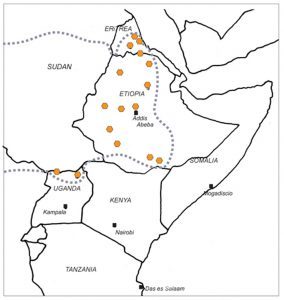Frankincense history is linked to the use of this incense in Biblical times. Frankincense is one of the most well-regarded ancient incense; frankincense has a fresh pine-lemon scent with resinous and woody overtones that emanate from the milky white latex of the stem and branches. The name frankincense comes from the French word franc encens, which means “pure incense” or “free lighting.” This name originated from the Frank Crusades of the 11th century when the Franks were believed to store large quantities of frankincense for use as incense and medicine. In Arabic, it is called luban, which means “white” or “cream,” and olibanum, which means “oil of Lebanon.” In Hebrew, it is called lebonah.
The resin is produced from multiple Boswellia species with varying aromas. The resin is extracted by steam or carbon dioxide distillation. Boswellia sacra syn B. carterii has terpenic and pine flavor; Boswellia papyrifera is fruity and citrus with soft orange notes; Boswellia frereana has a spicy scent similar to cumin; Boswellia neglecta has a mild, earthy, and slightly musty aroma; Boswellia rivae is soft, woody, and elegant; and Boswellia serrata has fresh lemon, citrus, and pine notes. B. carterii, B. frereana, B. papyrifera, and B. serrata of the Burseraceae family are the major sources of frankincense.
With its light lemony scent, Boswellia sacra are the most prized and are the species referred to most in the Bible. This tree grows today in Yemen and northern Somalia. Boswellia frereana and Boswellia thurifera, found in north Somalia, are sources of the Coptic frankincense. The Coptic Church prefers this incense. It, too, has a pleasant lemony scent and is also used in Arabian chewing gum.
Boswellia papyrifera is found in Kenya, Ethiopia, Eritrea, and Sudan in Africa. It has an orange scent and is used to produce the highest frankincense in the Afro-Arabian region. It is good for the stomach but can also cause stomach problems. B. serrata grows in the dry regions of India and yields an orange-scented gum that is of lower quality than that of B. sacra. Gum is a popular ingredient in Ayurvedic medicine.
Multiple references to frankincense in the Bible indicate its importance. The King James Bible contains 113 references to incense and 17 references to frankincense. The Hebrew people blended frankincense with other precious resins like myrrh to make Ketoret; the perfume used to prepare the Jewish temple for worship. The three Magi brought gifts of gold, myrrh, frankincense, and spices to Baby Jesus.
Egyptian ladies used to prepare kohl from burnt frankincense and use that as eyeliner. Tradition has it that Queen Sheba brought frankincense saplings from Arabia for King Solomon. This high premium continued until the 19th century AD, when improved logistics, chemical alternatives, and increased supply led to decreased prices.
People in the Mesopotamian, Arabian, and Mediterranean regions widely used frankincense. It has long been known to have inebriating, euphoric, and mood-enhancing effects. The Assyrians associated incense with the goddess Ishtar and the gods’ Adonis and Bel (Ratsch, 1998, 92).
Frankincense was a natural insecticide used by ancient Egyptians to fumigate wheat and grain stores and deter moths. In Arabia, they burned resin to keep mosquitoes and sand flies away. According to a reference in the Talmud, frankincense was given to intoxicating criminals before putting them to death.
Theophrastus, Dioscorides, and Pliny all mentioned the medicinal properties of frankincense. The Roman military physician Dioscorides used frankincense resin to treat soldiers’ wounds. Avicenna, the Arabic physician of the 11th century AD, recommended frankincense to reduce fevers.
In Traditional Chinese Medicine, frankincense (ru xiang) has been used for centuries. The first reference to frankincense is in the Chinese medicine book Mingyi Bielu, or Miscellaneous Records of Famous Physicians (c. 500 AD). It is regarded to have a positive effect on qi. It invigorates the blood, dispels blood stasis, and treats swelling, wounds, sore muscles, sores and boils, abdominal pain, dysmenorrhea, postpartum abdominal pain, and pain caused by trauma.

Trackbacks/Pingbacks